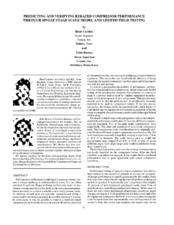| dc.contributor.other | Turbomachinery Symposium (22nd : 1993) | |
| dc.creator | Cardon, Brad | |
| dc.creator | Bartos, John | |
| dc.date.accessioned | 2017-10-05T14:11:54Z | |
| dc.date.available | 2017-10-05T14:11:54Z | |
| dc.date.issued | 1993 | |
| dc.identifier.uri | https://hdl.handle.net/1969.1/163505 | |
| dc.description | Lecture | en |
| dc.description | Pg. 91-100 | en |
| dc.description.abstract | Performance verification of centrifugal compressor rerates creates a unique challenge to turbomachinery users. It is not often practical to perform flange-to-flange performance tests on machinery already installed in the field, as the redundant instrumentation necessary to conduct a reliable test is rarely present onsite. In addition, rerated units are typically commissioned during a turnaround where time constraints do not allow the luxury of a test. In some cases, it may be possible to remove a relatively small compressor body from the site and shop test it. However, in almost all circumstances the cost associated with doing so is prohibitively expensive. This leaves the user faced with the dilemma of being uncertain of a rerated compressor's performance until it is actually run with the new process. A solution is proposed to the problem of performance verification for rerated centrifugal compressors. Single stage scale model testing of the aerodynamic elements that comprise a compressor stage is a proven method used by original equipment manufacturers in the development of new components. This practice may also be used to find the performance of aerodynamic elements intended to be used in compressor rerates. If the test proves successful, the design can be incorporated with a high degree of confidence that the equipment will operate as expected. After the rerate is complete, the performance can be verified through limited field testing. The details a single stage testing program as well as the independent field performance verification of four very different compressors are presented. Two of the units under consideration were single body. The other unit consisted of a two-body compressor train. The compressors under consideration were originally supplied by three different original equipment manufacturers. The full scale hardware consisted of impellers ranging in size from 17.0 in to 43.5 in in diameter. The scale factors used to model the aerodynamic stage ranged from 0.81 to 0.25. A total of seven different stages were single stage scale model tested between the three compressors. The limited field testing used only the existing instrumentation previously installed on the compressor trains. After the field variables were taken into account, it was found that the predicted performance was in good agreement with actual compressor operations. | en |
| dc.format.medium | Electronic | en |
| dc.format.mimetype | application/pdf | |
| dc.language.iso | en | |
| dc.publisher | Texas A&M University. Turbomachinery Laboratories | |
| dc.relation.ispartof | Proceedings of the 22nd Turbomachinery Symposium | en |
| dc.subject.lcsh | Turbomachines | en |
| dc.title | Predicting And Verifying Rerated Compressor Performance Through Single Stage Scale Model And Limited Field Testing. | en |
| dc.type.genre | Presentation | en |
| dc.type.material | Text | en |
| dc.identifier.doi | https://doi.org/10.21423/R1Q07F | |


